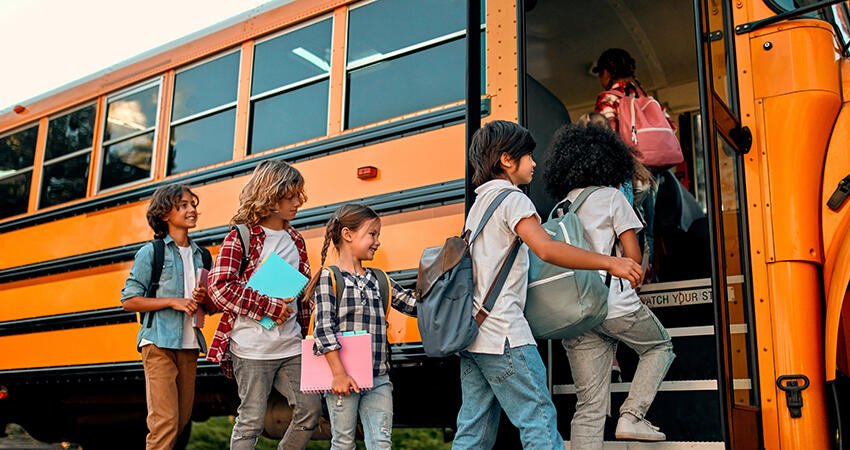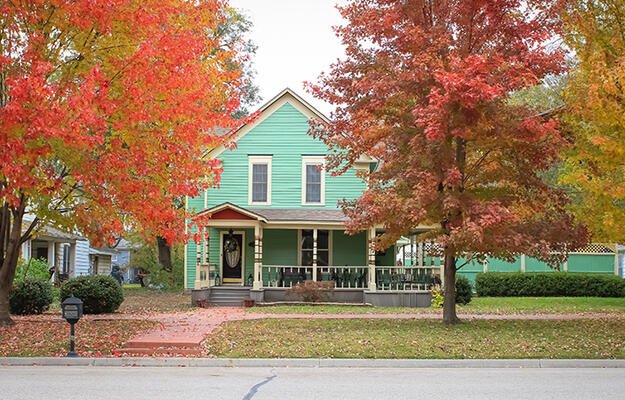
(4 PM production/Shutterstock)
How Students’ Transportation Options—or Lack Thereof—Affect Educational and Health Outcomes
Every day, millions of students pack into yellow buses, drive, bike, walk, or take one of many other forms of transportation to get to and from school. As such an integral part of students’ daily routines, how students are getting to and from schools is an important matter for both a student’s academic and health outcomes.
How do students commute?
Students use a variety of transportation methods to get to school, but the vast majority either use a car or take a school bus. The most recent National Household Travel Survey from 2017 found that on a typical school day, 54.2 percent of students were driven in a private vehicle, 33.2 percent took a school bus, and 10.4 percent walked. In recent years, there’s been a slight decline in the use of public school transport because factors such as school bus driver shortages and the COVID-19 pandemic have pushed more families to drive their children.
But for many students, the increasing reliance on private transportation may be a real barrier to school attendance. One analysis found that although a majority of students from families with high or middle incomes are driven to school in a personal vehicle, 20 percent of families with low incomes own no vehicles, and 60 percent of students from families with low incomes primarily ride the bus.
The lack of transportation options may be particularly challenging for students from families with low incomes who don’t attend their neighborhood school. Families of students who qualified for the federal free and reduced-price lunch program and attended charter and private schools were almost twice as likely to plan for their students to take a school bus compared with families with higher incomes at those same schools.
There are also disparities in the length of a student’s commute to school. A study that analyzed responses to the American Time Use Survey found that the average morning commute for a high schooler was about 18 minutes, but some students’ morning commutes are more than an hour. An Urban Institute report that looked at nearly 190,000 students across Denver, Detroit, New Orleans, New York City, and Washington, DC, found that Black students tend to travel farther than white or Latinx students, which may result from Black students living toward the edges of their school districts or living in areas separated by natural barriers like rivers or parks. Travel times to schools using public transit were also found to be significantly greater than travel times using a private car.
How do differing commute times and transportation access affect students?
A study found that a one-minute increase in school commute times was associated with a 1.3 minute reduction in sleep, meaning that if a given student had a commute 15 minutes longer than another student, they would be sleeping almost 20 minutes less on average. The same study also found that students with shorter commutes got more exercise relative to those with longer commutes. Given that sleep and exercise have well-established relationships to educational outcomes, students with longer commutes may face greater academic and overall health challenges as a result of their longer commute.
Another analysis of bus-riding students in New York City found that absenteeism and test scores were worse for students exercising school choice with commutes of over 45 minutes relative to their peers with shorter commutes.
For families with limited transportation access, the lack of transportation options can also limit their ability to attend better-quality schools that are slightly farther away. Limited transportation and the resulting lack of dispersion to schools outside of a family’s immediate neighborhood can then lead to economic and racial segregation within schools.
How can transportation barriers and inequities be addressed?
To address school transportation inequities and disparities, school officials and policymakers could consider adopting policies and interventions that increase and improve school transportation options.
State- and district-level policies that expand the coverage and efficiency of school bus routes could help alleviate the longer commute times and limited access to buses that students of color and students from low-income families often face. Cities like Boston have employed algorithmic bus routing to make their school bus system more efficient, which, in turn, has allowed the school district to reinvest over $5 million dollars into other school initiatives. Other districts have significantly increased school bus driver pay rates and offered signing bonuses with hopes of attracting more drivers.
Making public transportation more available appears to improve school attendance. A study in Michigan found that eligibility to ride the school bus increased attendance and decreased chronic absenteeism in students from families with low incomes relative to similar students from the same schools but who weren’t eligible for bus transportation.
Denver’s Success Express program, which circulates buses throughout certain neighborhoods before and after school, has been found to have increased access to school transportation and been associated with significant increases in school attendance. Additional interventions like providing targeted transportation vouchers or other financial assistance to families with low incomes could help address racial and socioeconomic inequities.
Improving school transportation access for families with low incomes and families of color can help students turn improved transportation outcomes into improved educational outcomes.


